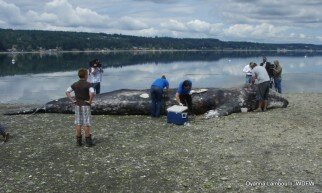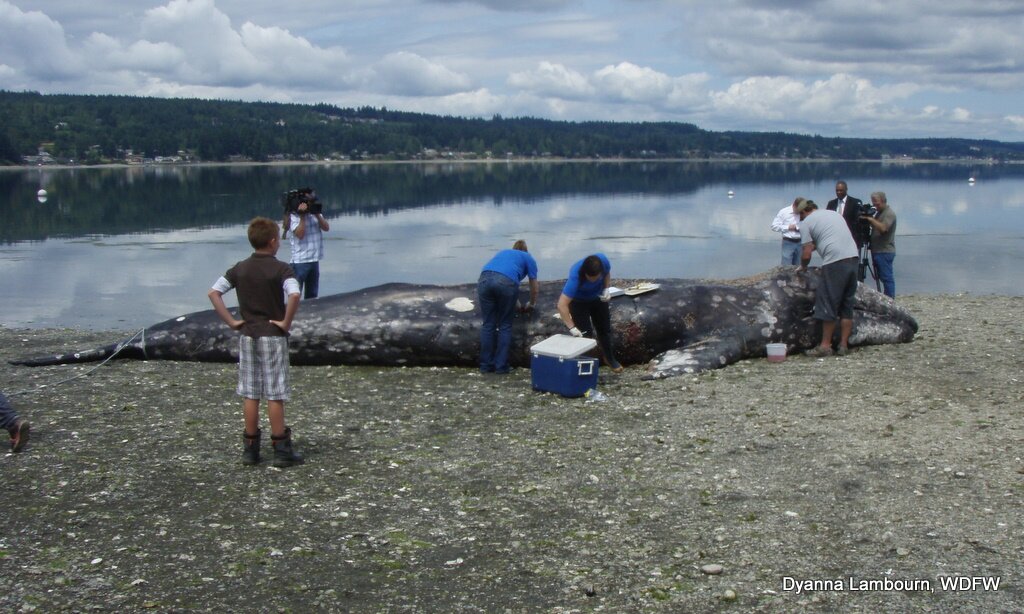
On July 27, a resident of Erlands Point Road noticed a gray whale on the beach. “I thought it was a log at first, then I saw the breathing,” Jim Ryan told the Kitsap Sun. “It looked pretty beat up.”
The whale was 30 feet long, likely a juvenile, and emaciated, and died within two hours. Cascade Research and Washington Department of Fish and Wildlife biologists plan to do a necropsy to try to determine an official cause of death, but on average four to six gray whales strand themselves each year on Washington beaches.
Gray whales will grow to about 50 feet in length and live up to 70 years. Each spring, gray whales migrate between Baja and the Arctic, showing up off the Washington coast by late March through early May. A few hundred whales make up the Pacific Coast Feeding Group; these apparently don’t care for either Arctic waters or long-distance travel, remaining off the Pacific coast instead, while the rest make the 5,000-7,000 mile journey.
Outside of an as-yet-contentious die-off in 1999-2000, when 50 gray whales washed up in Washington alone, and the overall population dropped by perhaps 6,000, the eastern Pacific gray whale population is keeping to around 20,000. (They’ve been protected from commercial hunting by the International Whaling Commission since 1949.)
The initial hypothesis on the die-off was that it was a success story–there were now so many gray whales that they had exceeded the available food supply. But Stephen Palumbi, a Stanford University marine sciences professor, made news in 2007 by arguing that, based on genetic diversity, the total gray whale population had once been closer to 100,000.
This estimate has remained difficult to reconcile with known whaling results, though Palumbi points to the critically endangered population of the northwest Pacific as the likely reservoir of “missing” whales.
Whatever the oceans could once support, NOAA researchers estimate that the eastern Pacific gray whale contingent bumps up against current food supply limits at around 25,000. (See pdf of “Population status of the eastern North Pacific stock of gray whales in 2009.”) Increasingly, researchers have wondered how climate change is affecting the whales’ Arctic feeding grounds.
A 2011 paper,”What Happened to Gray Whales during the Pleistocene? The Ecological Impact of Sea-Level Change on Benthic Feeding Areas in the North Pacific Ocean,” has revisited the census vs. genetics debate:
This census-based estimate, however, conflicts by orders of magnitude with molecular analyses of gray whale genetic diversity, which suggest that pre-whaling population sizes were dramatically larger, up to 118 k individuals. (This molecular estimate covered the entirety of possible North Pacific metapopulations, although distributing the mean molecular value across both western and eastern population still indicates that eastern gray whales are 28–56% of their historical abundances.) If the molecular data on historical, pre-whaling estimates of gray whale population size are accurate, then the fixation of today’s population at much lower carrying capacity may indicate that the structure of nearshore ecosystems in the North Pacific has fundamentally changed over the past few centuries.
Co-author and evolutionary biologist David Lindberg, at UC Berkeley, suggests that the answer to the discrepancy may lie in the behavior of the gray whales who take up summer homes off northern Washington State and Vancouver Island. They’re believed to feed on herring and krill, rather than primarily sucking up nutrients from an ocean floor sediment slurry. Lindberg says it’s the earlier whaling that may have harassed gray whales into their arduous migrations and bottom-feeding. Now that the coast is clear, the whales could be relaxing into old habits, but finding the coastal corner stores don’t carry as much as they used to.
NOAA’s Dave Weller has read Lindberg’s paper and agrees that gray whales “are definitely a catholic feeder,” with an opportunistic edge. But he says the evidence isn’t there for large-scale emaciation due to food supply shortages (caused by climate change or other factors). Clearly, he says, the melting of Arctic sea ice has prompted a redistribution of ocean-floor (or “benthic”) food sources.
Due to increased sunlight penetration and water temperatures, the nutrient base that nourishes ocean-floor life (such as the amphipods that gray whales hoover up) has been shifting over the past two decades, and the gray whales have expanded their range from the Chukchi Basin to the Beaufort Sea. Presumably they’re chasing their food, but in fact “we don’t have very good data on the abundance of food” across their feeding area, says Weller.
What Weller and others believe is that, actually, gray whales are one of the species poised to take advantage of climate change’s swiftness–as it mows down less flexible eaters, the whales will find more elbow fluke room at the dining table. We will have to hope that we are no less adaptable with how we eat.
